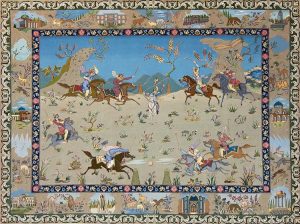Polo Rug and the History of Polo Sport
The History of Polo Sport: A Game of Kings

The history of polo sport stretches back over two and a half millennia, making it one of the oldest known team sports in the world. Originating in ancient Persia around the 6th century BC, polo was far more than just a game; it was a training exercise for cavalry units, honing the riding skills, precision, and coordination of warriors. Often referred to as “the game of kings,” polo quickly became a prestigious pastime among Persian nobility and military elites.
From Persia, polo spread eastward to India, Tibet, and China, carried along the Silk Road by traders, adventurers, and warriors. Each culture adapted the sport to its traditions, but the essence of polo—speed, teamwork, and horsemanship—remained constant. In the 19th century, British officers stationed in India adopted polo, eventually introducing it to England and, subsequently, to the rest of the Western world. Today, polo is played in more than 80 countries, continuing to embody a blend of athleticism, elegance, and strategy.
Timeline of Polo History
To truly appreciate the history of polo sport, here’s a concise timeline highlighting its evolution:
- 6th Century BC – Ancient Persia: Polo emerges as a training exercise for cavalry, quickly becoming a sport among Persian nobility.
- Tang Dynasty, 7th–9th Century AD – China: Polo gains popularity among the Chinese elite, often played at the imperial court.
- 13th Century – Middle East & Central Asia: The sport thrives in Persia, India, and the Mongol Empire, with variations in rules and styles.
- 16th–17th Century – Safavid Persia: Polo reaches its artistic and cultural peak, inspiring miniature paintings and courtly events.
- 19th Century – British India: British officers encounter polo in India, formalize its rules, and introduce it to England.
- Late 19th Century – Global Expansion: Polo spreads to Argentina, the United States, and beyond, gaining elite sporting status.
- Modern Day: Polo is played worldwide, with major tournaments in Argentina, the U.S., the UK, and the Middle East.
The Cultural Significance of Polo Sport
The history of polo sport is also a story of cultural exchange and diplomacy. In Persia, polo matches were often grand events attended by royalty, dignitaries, and the public. They showcased not just physical skill, but also artistry—beautifully adorned horses, traditional uniforms, and elaborate celebrations surrounding the games.
In later centuries, polo became a symbol of sophistication and exclusivity, associated with prestigious clubs, luxury estates, and the global elite. Yet, despite its reputation for glamour, polo’s roots are grounded in discipline, teamwork, and a shared passion for the game between rider and horse.
Capturing Polo’s Spirit in Art
Polo has inspired countless works of art, from miniature Persian paintings to large-scale murals. In the decorative arts, the sport’s dynamic imagery—horses galloping at full speed, players leaning forward for the perfect swing—became a favored subject for artisans. In Persia’s weaving centers, master rug makers began incorporating polo scenes into their designs, turning the game into a timeless motif woven into silk and wool.
These pictorial rugs did more than decorate homes; they told stories. They were a way of preserving the history of polo sport visually, allowing future generations to witness the energy and elegance of the game through detailed craftsmanship.
The Magnificent Persian Polo Rug
At Beautiful Rugs in Chicago, we are proud to present a stunning example of this tradition: our Handmade Persian Tabriz Pictorial Polo Rug. This exceptional piece captures the thrill of the game in exquisite woven detail. Crafted from the finest kork wool and silk on a silk foundation, the rug showcases riders in motion, mallets raised, and horses in mid-gallop—a scene that feels alive with the spirit of competition.
At 45 years old, this polo rug is in immaculate condition, a testament to both the skill of the Tabriz weavers and the care it has received. Measuring 6.9 x 5 feet, it is versatile enough to serve as a captivating wall hanging or a luxurious floor covering. Whether placed in a living room, study, or even a polo club lounge, it exudes sophistication and serves as a conversation starter for guests and fellow polo enthusiasts.
Why the Polo Rug is More Than Décor
Owning a Persian polo rug is more than just adding a decorative item to your space—it’s embracing a piece of history. This rug connects the modern admirer of polo to its ancient Persian roots, merging fine art with the heritage of the sport. For those who appreciate the history of polo sport, it’s a tangible reminder of the game’s legacy and a celebration of its artistry.
Each time you admire the rug’s intricate design, you’re not just seeing a beautiful textile—you’re stepping into a story that began on the plains of ancient Persia, where warriors on horseback refined their skills in a sport that would endure for centuries.
Conclusion: A Celebration of Sport and Art
The history of polo sport and the tradition of Persian rug weaving share a common thread: both are art forms that demand skill, patience, and an eye for beauty. This handmade Persian Tabriz polo rug honors that shared heritage, capturing a fleeting moment of action in a permanent, timeless medium.
For polo enthusiasts, collectors, and lovers of fine art, this rug is more than a purchase—it’s a legacy. It’s a bridge between the elegance of an ancient sport and the meticulous artistry of Persian weaving. Whether displayed in a home, office, or clubhouse, it will continue to inspire admiration for both the game of kings and the artisans who have preserved its image for generations.